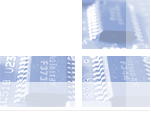


| Home | Solutions | Publications | Downloads | FAQ | Links | About us | Contact |
|
Available applications • 2D to 3D conversion: The MOLGEO software has been adapted for the conversion of 2D structures to 3D representations. This is a common data pre-processing task in the QSPR/QSAR modelling, since the 2D representation is very convenient to the end-user for sketching molecular structures and most chemical databases have only 2D representations available. However, all quantum chemical and most molecular descriptor calculation programs require the 3D representation of molecular structures as an input.• Semi-empirical quantum chemical calculations: The MOPAC (version 7) software has been adapted for the semi-empirical quantum chemical calculations. MOPAC is a general-purpose semi-empirical quantum mechanics package for the study of chemical properties and reactions in gas, solution or solid-state. The output from MOPAC calculations is used to calculate quantum-chemical descriptors (e.g. dipole moment, heat of formation, energy partitioning, reactivity indexes, etc.) for the QSAR/QSPR model development. • Descriptor calculation: The MDC module from the CODESSA PRO software has been adapted for the molecular descriptor calculation. Currently the system incorporates a wide range (about 1000) of molecular descriptors, describing constitutional, topological, structural and electronic features of structures. The descriptor calculation task is applicable both to 2D and 3D structures, although 3D structures provide more information rich description of molecules. • Model development: The MDA module from the CODESSA PRO software has been adapted for the QSAR/QSPR model development. Multiple statistical methods are available for the development of predictive models, including Multilinear Regression Models (MLR) and Partial Least Squares (PLS). Several selection algorithms are available for descriptor selection in the effective search of the best (most informative) multi-parameter correlations in the large space of the natural descriptors. The prediction capability of the model is judged by statistical parameters calculated for the model, various cross-validation techniques, internal and external validation sets. Visualisation tools are available for plotting actual vs. predicted activities/properties and residuals Back to Data Mining |